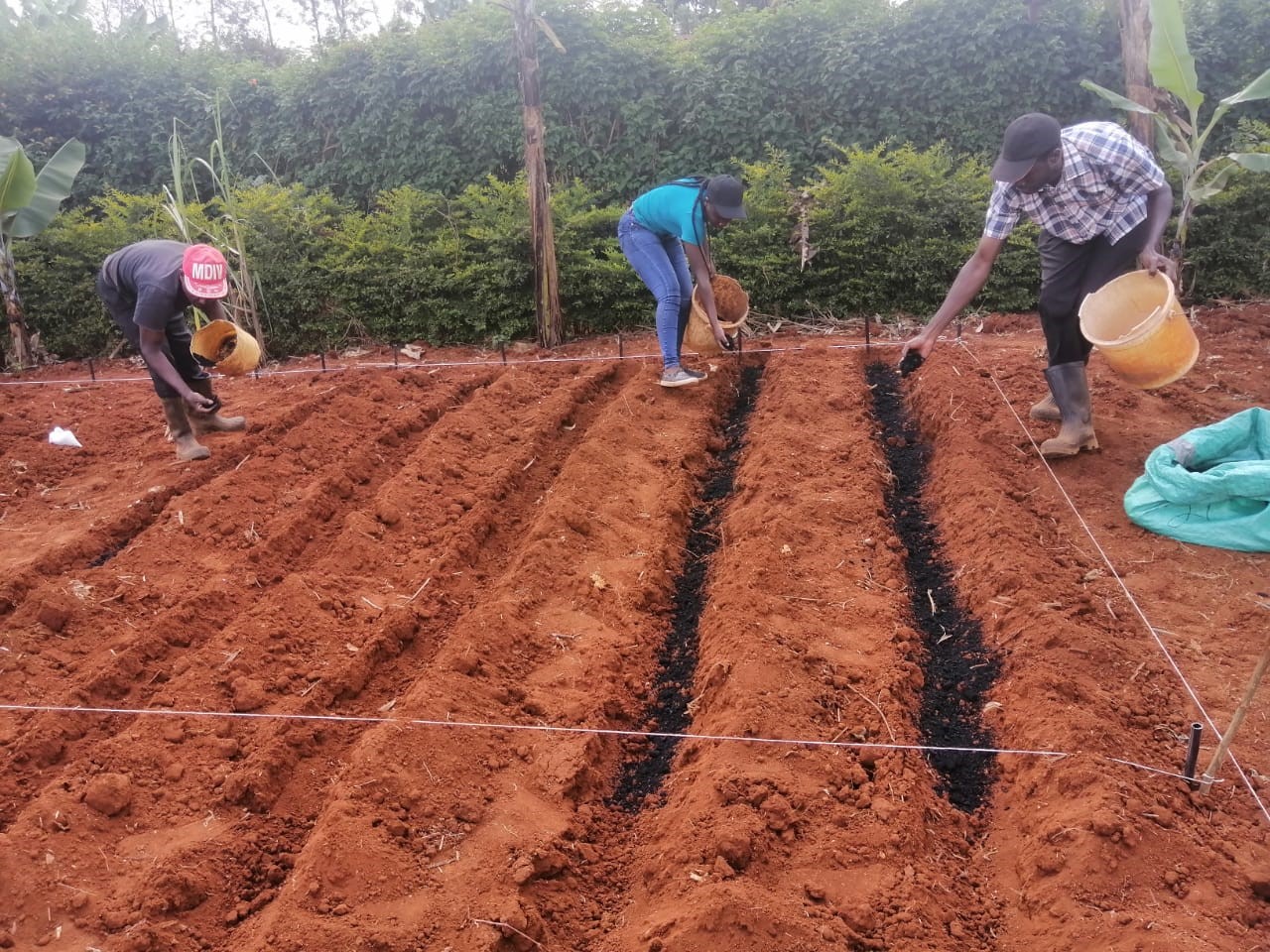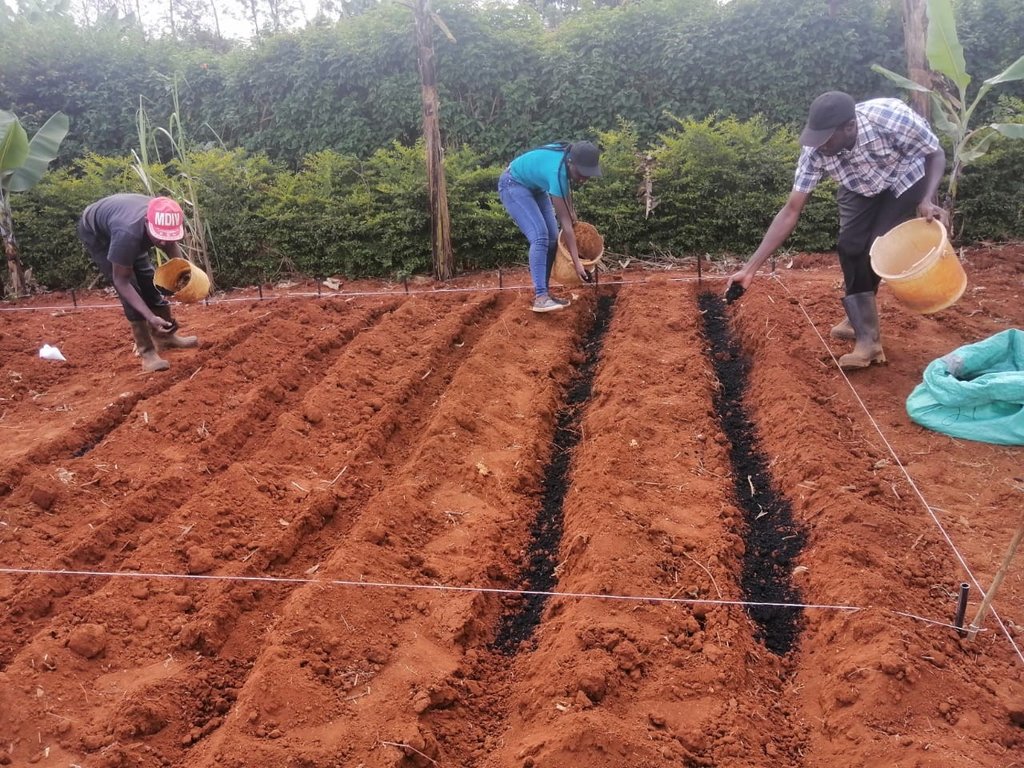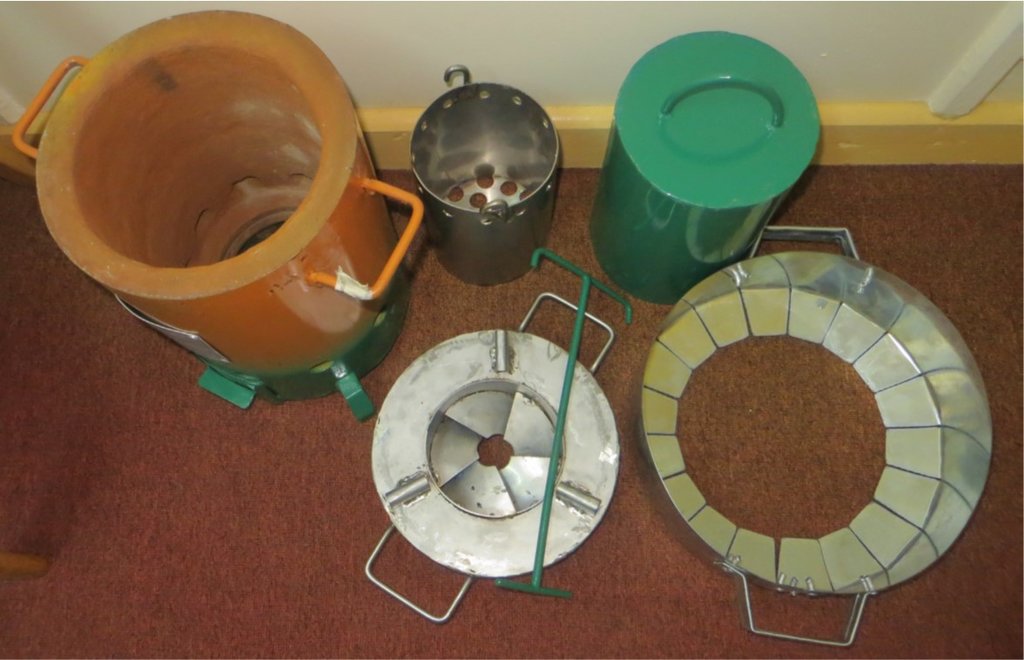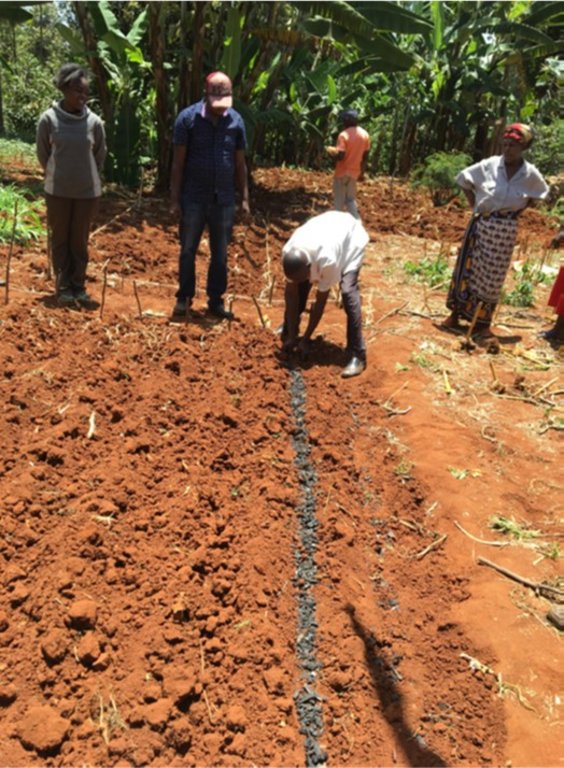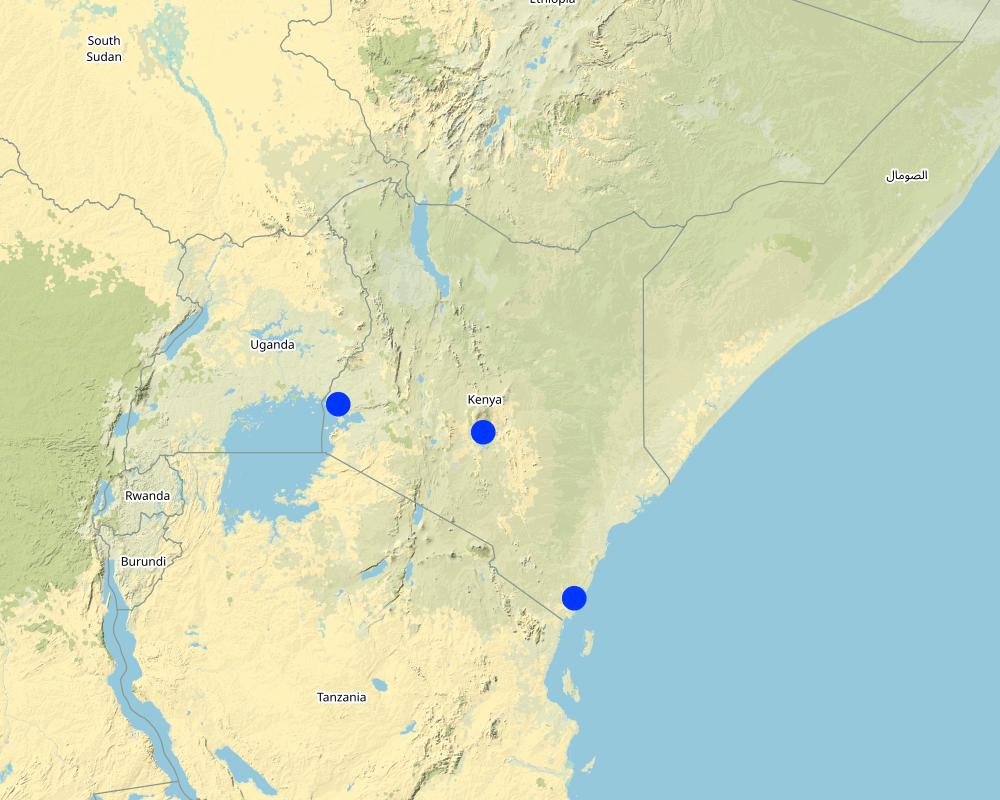Biochar application by smallholder farmers [ប្រទេសកេនយ៉ា]
- ការបង្កើត៖
- បច្ចុប្បន្នភាព
- អ្នកចងក្រង៖ Niels Thevs
- អ្នកកែសម្រួល៖ Dries Roobroeck
- អ្នកត្រួតពិនិត្យច្រើនទៀត៖ William Critchley, Rima Mekdaschi Studer
technologies_6349 - ប្រទេសកេនយ៉ា
ពិនិត្យមើលគ្រប់ផ្នែក
ពង្រីកមើលទាំងអស់ បង្រួមទាំងអស់1. ព័ត៌មានទូទៅ
1.2 ព័ត៌មានលម្អិតពីបុគ្គលសំខាន់ៗ និងស្ថាប័នដែលចូលរួមក្នុងការវាយតម្លៃ និងចងក្រងឯកសារនៃបច្ចេកទេស
co-compiler:
co-compiler:
Roebroock Dries
IITA
ប្រទេសកេនយ៉ា
ឈ្មោះអង្គភាពមួយ (ច្រើន) ដែលបានចងក្រងឯកសារ/ វាយតម្លៃបច្ចេកទេស (បើទាក់ទង)
Deutsche Gesellschaft für Internationale Zusammenarbeit (GIZ) GmbH (GIZ) - ប្រទេសអាល្លឺម៉ង់1.3 លក្ខខណ្ឌទាក់ទងទៅនឹងការប្រើប្រាស់ទិន្នន័យដែលបានចងក្រងតាមរយៈ វ៉ូខេត
អ្នកចងក្រង និង(បុគ្គលសំខាន់ៗ)យល់ព្រមទទួលយកនូវលក្ខខណ្ឌនានាទាក់ទងទៅនឹងការប្រើប្រាស់ទិន្នន័យដែលបានចងក្រងតាមរយៈវ៉ូខេត:
បាទ/ចា៎
1.4 សេចក្តីប្រកាសស្តីពីចីរភាពនៃការពណ៌នាពីបច្ចេកទេស
តើបច្ចេកទេសដែលបានពណ៌នានេះមានបញ្ហាដែលផ្តោតលើការធ្លាក់ចុះគុណភាពដី, បើដូច្នេះវាមិនអាចត្រូវបានប្រកាសថាជាបច្ចេកទេសនៃការគ្រប់គ្រងប្រកបដោយចីរភាពទេ?
ទេ
2. ការពណ៌នាពីបច្ចេកទេស SLM
2.1 ការពណ៌នាដោយសង្ខេបពីបច្ចេកទេស
និយមន័យបច្ចេកទេស:
Application of biochar to soils in the tropics / sub-tropics improves their ability to store and supply nutrients and water for crop growth, thereby enhancing yields and food security. At the same time, biochar holds carbon in soils for extended time periods, which makes it an agricultural practice that contributes to climate change mitigation.
2.2 ការពណ៌នាលម្អិតពីបច្ចេកទេស
ការពណ៌នា:
Biochar is carbonised organic material that is produced through pyrolysis, that is thermal conversion under low or no oxygen. The biochar is used as an amendment to farmland for ameliorating soil properties. Owing to the great number of micropores and charges on biochar, its application to soil boosts water and nutrient storage, and their delivery to crops. Biochar also helps neutralise acidity in soils, replacing the need for lime. All these positive effects make it ideally suited for acid, nutrient-poor soils in tropical/ sub-tropical regions. Even at low rates of 1 or 2 tonnes per hectare, biochar significantly increases crop production. Biochar hardly decomposes in soils, causing positive effects to last for several years without repeat application. This also provides very stable carbon storage on farms which helps mitigate climate change. Its stability also allows farmers to gradually add biochar to the entire farm, thereby increasing their food self-sufficiency and incomes.
Biochar itself is not a fertilizer, but a soil rejuvenating agent. Therefore, farmers must apply essential nutrients through synthetic or organic inputs to reap the full yield potential and maintain soil fertility. Yet, when biochar is combined with fertilizers, about 40% - 70% nitrogen and phosphorus can be saved over multiple seasons while maintaining the same productivity. Biochar is a promising solution to address low response of crops to fertilizer addition in tropical soils and to alleviate the impact of input price hikes and supply disruptions.
In the study presented here, farmers produced biochar as a residue from small gasifier stoves during daily cooking. These systems are highly energy efficient and reduce the consumption of firewood while improving indoor air quality, which, alongside crop yield gains from biochar, is perceived positively by farmers. The specific design of gasifier stoves requires them to be well-packed with appropriately sized tree prunings or maize stems. For larger meals it requires a refill, which users find less convenient than their traditional open combustion fires. Life-cycle assessment shows that households significantly reduce greenhouse gas emissions with the gasifier stoves when biochar is applied to the farm. For the field trials with maize and kale in this study, farmers applied their usual rates of inorganic fertilizers, animal manure, or a combination of both. Results from this multi-locational participatory assessment showed that maize grain yield increased by 0.2 - 0.7 tonnes per hectare for every tonne of home-made biochar that was added to the field.
One household can produce 300 kg biochar per year by cooking on the gasifier stove. With this amount a biochar dosage of 1.5 t/ha can be realized on an area of 0.2 ha per year. If biochar is not spread evenly, but along seed rows, its effective dosage can be increased. As the gasifier stove can be operated for 2-3 years, it is assumed that the costs of 50 USD, which are needed to purchase one gasifier, are good to equip 1 ha of land with an amount of biochar that results in increased crop yields.
2.3 រូបភាពនៃបច្ចេកទេស
កំណត់សម្គាល់ទូទៅនៃរូបថត/រូភាព:
Both photographs were taken from the publication: Njenga M, Sundberg C, Gitau JK, Mahmoud Y, Röing de Nowina K, Mendum R and Karltun E 2020. Biochar stoves for socio-ecological resilience: Lessons from small-scale farms in rural Kenya. Policy Brief No 51. Nairobi, Kenya. World Agroforestry (ICRAF)
2.5 ប្រទេស/តំបន់/ទីតាំងកន្លែង ដែលបច្ចេកទេសត្រូវបានអនុវត្ត និងបានគ្រប់ដណ្តប់ដោយការវាយតម្លៃនេះ
ប្រទេស:
ប្រទេសកេនយ៉ា
តំបន់/រដ្ឋ/ខេត្ត:
Embu County, Kwale County, Siaya County
បញ្ជាក់ពីការសាយភាយនៃបច្ចេកទេស:
- អនុវត្តនៅកន្លែងជាក់លាក់មួយ/ ប្រមូលផ្តុំនៅតំបន់តូចៗ
តើបច្ចេកទេស (មួយ ឬច្រើន) ទាំងនោះស្ថិតនៅក្នុងតំបន់ការពារជាអចិន្ត្រៃយ៍ណាមួយដែរឬទេ?
ទេ
Map
×2.6 កាលបរិច្ឆេទនៃការអនុវត្ត
បង្ហាញឆ្នាំនៃការចុះអនុវត្ត:
2016
2.7 ការណែនាំពីបច្ចេកទេស
សូមបញ្ជាក់តើបច្ចេកទេសត្រូវបានណែនាំឱ្យអនុវត្តដោយរបៀបណា:
- ពេលកំពុងពិសោធន៍
មតិយោបល់ (ប្រភេទនៃគម្រោង ។ល។):
IITA (International Institute of Tropical Agriculture) started a long-term field trial in 2006, in which crop and soil properties were monitored following one initial biochar application of 100 t/ha. ICRAF investigated the charcoal value chain in Kenya and, among others, promoted cooking stoves which were more efficient than the traditionally used open fires. Those stoves run on pyrolysis, which provides heat for cooking and charcoal as a residual. That charcoal can be used for cooking so that the initial biomass is used more efficiently as an energy source. Or, alternatively, the residual charcoal is used as biochar to improve the farmers' soils.
This combination of cooking and biochar production and application to soils began in 2016 as participatory research.
3. ចំណាត់ថ្នាក់នៃបច្ចេកទេស SLM
3.1 គោលបំណងចម្បង (១ ឬច្រើន) នៃបច្ចេកទេសនេះ
- ធ្វើឱ្យប្រសើរឡើងនូវផលិតកម្ម
- បន្ស៊ាំទៅនឹងការប្រែប្រួលអាកាសធាតុ/គ្រោះមហន្តរាយ និងផលប៉ះពាល់របស់វា
- កាត់បន្ថយការប្រែប្រួលអាកាសធាតុ និងផលប៉ះពាល់របស់វា
- បង្កើតផលប្រយោជន៍សេដ្ឋកិច្ច
- បង្កើតផលប្រយោជន៍សង្គម
3.2 ប្រភេទដីប្រើប្រាស់មួយប្រភេទ (ច្រើនប្រភេទ) ដែលបានអនុវត្តបច្ចេកទេស
ដីប្រើប្រាស់ចម្រុះនៅលើដីតែមួយ:
ទេ

ដីដាំដំណាំ
- ដំណាំប្រចាំឆ្នាំ
ដំណាំប្រចាំឆ្នាំ - បញ្ជាក់ប្រភេទដំណាំ:
- ធញ្ញជាតិ - ពោត
- បន្លែ - បន្លែយកស្លឹក (សាលាដ ស្ពៃក្តោប ផ្ទី ផ្សេងៗ)
ចំនួនសារដែលដាំដំណាំក្នុងមួយឆ្នាំ:
- 2
សូមបញ្ជាក់:
2 seasons in Embu and Siaya, 1 season in Kwale
តើជាការអនុវត្តន៍ដំណាំចន្លោះ?
បាទ/ចា៎
ប្រសិនបើបាទ/ច៎ា សូមបញ្ជាក់ប្រភេទដំណាំដែលដាំចន្លោះគ្នានោះ:
Part of the households intercrop maize with beans.
តើជាការអនុវត្តន៍ដំណាំវិលជុំ?
ទេ
3.3 បន្ទាប់ពីអនុវត្តបច្ចេកទេស តើដីប្រើប្រាស់មានការប្រែប្រួលដែររឺទេ?
បន្ទាប់ពីអនុវត្តបច្ចេកទេស តើដីប្រើប្រាស់មានការប្រែប្រួលដែររឺទេ?
- ទេ (បន្តទៅសំណួរ 3.4)

ដីដាំដំណាំ
- ដំណាំប្រចាំឆ្នាំ
ដំណាំប្រចាំឆ្នាំ - បញ្ជាក់ប្រភេទដំណាំ:
- ធញ្ញជាតិ - ពោត
តើជាការអនុវត្តន៍ដំណាំចន្លោះ?
បាទ/ចា៎
ប្រសិនបើបាទ/ច៎ា សូមបញ្ជាក់ប្រភេទដំណាំដែលដាំចន្លោះគ្នានោះ:
maize and beans
តើជាការអនុវត្តន៍ដំណាំវិលជុំ?
ទេ
3.4 ការផ្គត់ផ្គង់ទឹក
ការផ្គត់ផ្គង់ទឹកនៅកន្លែងអនុវត្តបច្ចេកទេស:
- ទឹកភ្លៀង
3.5 ក្រុម SLM ដែលបច្ចេកទេសស្ថិតនៅក្នុង
- ការគ្រប់គ្រងជីជាតិដីតាមបែបចម្រុះ
3.6 វិធានការ SLM ដែលបញ្ចូលនូវបច្ចេកទេស

វិធានការក្សេត្រសាស្ត្រ
- A2: សារធាតុសរីរាង្គ/ជីជាតិដី
3.7 កំណត់ប្រភេទនៃការធ្លាក់ចុះគុណភាពដីសំខាន់ៗដែលបច្ចេកទេសនេះបានដោះស្រាយ

ការធ្លាក់ចុះសារធាតុគីមីក្នុងដី
- Cn: ការថយចុះជីជាតិ និងកាត់បន្ថយបរិមាណសារធាតុសរីរាង្គ (មិនកើតឡើងដោយការហូរច្រោះទេ)
- Ca: អាស៊ីតកម្ម

ការបាត់បង់រូបសាស្ត្រនៃដី
- Pc: ការហាប់ណែន
- Pi: ការគ្របផ្ទៃដី
មតិយោបល់:
Biochar increases the cation exchange capacity of soils and enhances the plant availability of phosphorus so that it contributes to soil fertility. Biochar increases the soil pH so that it treats acidification of soils. In the field of soil physical properties, biochar decreases the bulk density of soils and adds pore space to soils so that the infiltration into the soil and the usable field capacity of soils are increased. In this specific case, soil sealing and compaction do not play a role, but biochar can address those soil degradation issues.
3.8 ការពារ កាត់បន្ថយ ឬស្តារឡើងវិញនៃការធ្លាក់ចុះគុណភាពដី
បញ្ជាក់ពីគោលដៅរបស់បច្ចេកទេស ដែលផ្តោតទៅការធ្លាក់ចុះគុណភាពដី:
- ការកាត់បន្ថយការធ្លាក់ចុះគុណភាពដី
- ការជួសជុល/ ស្តារឡើងវិញនៃឱនភាពដីធ្ងន់ធ្ងរ
4. បច្ចេកទេសជាក់លាក់ សកម្មភាពអនុវត្ត ធាតុចូល និងថ្លៃដើម
4.2 ព័ត៌មានទូទៅដែលពាក់ព័ន្ធនឹងការគណនាធាតុចូល និងថ្លៃដើម
កំណត់របៀបនៃការគណនាថ្លៃដើម និងធាតុចូល:
- ក្នុងឯកតាបច្ចេកទេស
បញ្ជាក់ឯកតា:
one gasifier cooking stove and the resulting amount of biochar
កំណត់រូបិយប័ណ្ណសម្រាប់ថ្លៃដើម:
- ដុល្លារ
4.3 សកម្មភាពបង្កើត
| សកម្មភាព | រយៈពេល (រដូវកាល) | |
|---|---|---|
| 1. | Biochar production | Year-round while using the gasifier cooking stove. |
| 2. | Mixing biochar into the soil | During the normal time of field preparation for and planting of the next crop |
| 3. | Proceed with normal cropping activities |
មតិយោបល់:
This SLM technique adds biochar to the ongoing cropping activities. So, the choice of crops, soil preparation, planting, inputs, and harvest do not change after biochar application. The biochar is sourced from so-called gasifier cooking stoves, which are stoves that perform through pyrolysis. The excess energy of that pyrolysis is used for cooking, while the residual char is applied as biochar to the farmers' field. Char (biochar) is produced during every cooking activity, collected, and finally applied. Most household in the project regions use open three-stone fires for cooking followed by charcoal. Adoption of the gasifier stoves is a shift away from the open fires and charcoal.
4.4 ថ្លៃដើម និងធាតុចូលដែលត្រូវការសម្រាប់ការបង្កើតបច្ចេកទេស
| បញ្ជាក់ពីធាតុចូល | ឯកតា | បរិមាណ | ថ្លៃដើមក្នុងមួយឯកតា | ថ្លៃធាតុចូលសរុប | % នៃថ្លៃដើមដែលចំណាយដោយអ្នកប្រើប្រាស់ដី | |
|---|---|---|---|---|---|---|
| កម្លាំងពលកម្ម | gasifier cooking stove | 1,0 | 50,0 | 50,0 | ||
| ថ្លៃដើមសរុបក្នុងការបង្កើតបច្ចេកទេស | 50,0 | |||||
| ថ្លៃដើមសរុបក្នុងការបង្កើតបច្ចេកទេសគិតជាដុល្លារ | 50,0 | |||||
មតិយោបល់:
As costs we only listed the 50 USD per gasifier cooking stove. As the other farm operations do not change, no further costs for plant materials or fertilizers or other were listed, because those inputs do not change solely due to the use of biochar from the gasifier stoves.
One household can produce 300 kg biochar per year by cooking on the gasifier stove. With this amount a biochar dosage of 1.5 t/ha can be realized on an area of 0.2 ha per year. If biochar is not spread evenly, but along seed rows, its effective dosage can be increased. As the gasifier stove can be operated for 2-3 years, it is assumed that the costs of 50 USD are good to equip 1 ha of land with an amount of biochar that results in increased crop yields.
4.5 សកម្មភាពថែទាំ
| សកម្មភាព | ពេលវេលា/ ភាពញឹកញាប់ | |
|---|---|---|
| 1. | Replace the gasifier cooking stove | every three years |
មតិយោបល់:
Once biochar has been applied into a given soil, it sits there in the soil and does not require further maintenance. The farming activities and their associated labor remain unchanged compared to the the time before biochar application.
4.6 កំណត់ថ្លៃដើមសម្រាប់ការថែទាំ/ សកម្មភាពរបស់បច្ចេកទេស (ក្នុងរយៈពេលមួយឆ្នាំ)
| បញ្ជាក់ពីធាតុចូល | ឯកតា | បរិមាណ | ថ្លៃដើមក្នុងមួយឯកតា | ថ្លៃធាតុចូលសរុប | % នៃថ្លៃដើមដែលចំណាយដោយអ្នកប្រើប្រាស់ដី | |
|---|---|---|---|---|---|---|
| សម្ភារៈ | gasifier cooking stove | 1 | 0,33 | 50,0 | 16,5 | 100,0 |
| ថ្លៃដើមសរុបសម្រាប់ការថែទាំដំណាំតាមបច្ចេកទេស | 16,5 | |||||
| ថ្លៃដើមសរុបសម្រាប់ការថែទាំដំណាំតាមបច្ចេកទេសគិតជាដុល្លារ | 16,5 | |||||
មតិយោបល់:
The depreciation of the gasifier cooking stove and the need to replace it every three years is included here unde rrecurrent costs.
4.7 កត្តាសំខាន់បំផុតដែលមានឥទ្ធិពលដល់ការចំណាយ
ពណ៌នាពីកត្តាប៉ះពាល់ចម្បងៗទៅលើថ្លៃដើម:
Purchase price of the gasifier stove. Opportunity cost for collection and pre-processing of tree prunings and crop residues for the stove.
5. លក្ខណៈបរិស្ថានធម្មជាតិ និងមនុស្ស
5.1 អាកាសធាតុ
បរិមាណទឹកភ្លៀងប្រចាំឆ្នាំ
- < 250 មម
- 251-500 មម
- 501-750 មម
- 751-1,000 មម
- 1,001-1,500 មម
- 1,501-2,000 មម
- 2,001-3,000 មម
- 3,001-4,000 មម
- > 4,000 មម
លក្ខណៈពិសេស/ មតិយោបល់លើរដូវភ្លៀង:
Embu: 1200 mm, Siaya: 1350 mm, Kwale 1050 mm
តំបន់កសិអាកាសធាតុ
- មានភ្លៀងមធ្យម
5.2 សណ្ឋានដី
ជម្រាលជាមធ្យម:
- រាបស្មើ (0-2%)
- ជម្រាលតិចតួច (3-5%)
- មធ្យម (6-10%)
- ជម្រាលខ្ពស់បន្តិច (11-15%)
- ទីទួល (16-30%)
- ទីទួលចោត (31-60%)
- ទីទួលចោតខ្លាំង (>60%)
ទម្រង់ដី:
- ខ្ពង់រាប
- កំពូលភ្នំ
- ជម្រាលភ្នំ
- ជម្រាលទួល
- ជម្រាលជើងភ្នំ
- បាតជ្រលងភ្នំ
តំបន់តាមរយៈកម្ពស់ :
- 0-100 ម
- 101-500 ម
- 501-1,000 ម
- 1,001-1,500 ម
- 1,501-2,000 ម
- 2,001-2,500 ម
- 2,501-3,000 ម
- 3,001-4,000 ម
- > 4,000 ម
បញ្ជាក់ថាតើបច្ចេកទេសនេះត្រូវបានអនុវត្តន៍នៅក្នុង:
- មិនពាក់ព័ន្ធទាំងអស់
មតិយោបល់ និងបញ្ចាក់បន្ថែមអំពីសណ្ឋានដី :
Kwale: 328 m a.s.l.
Embu: 1350 m a.s.l.
5.3 ដី
ជម្រៅដីជាមធ្យម:
- រាក់ខ្លាំង (0-20 សម)
- រាក់ (21-50 សម)
- មធ្យម (51-80 សម)
- ជ្រៅ (81-120 សម)
- ជ្រៅខ្លាំង (> 120 សម)
វាយនភាពដី (ស្រទាប់លើ):
- មធ្យម (ល្បាយ, ល្បាប់)
វាយនភាពដី (> 20 សម ស្រទាប់ក្នុង):
- មធ្យម (ល្បាយ, ល្បាប់)
សារធាតុសរីរាង្គនៅស្រទាប់ដីខាងលើ:
- មធ្យម (1-3%)
បើអាចសូមភ្ជាប់ការពណ៌នាពីដីឱ្យបានច្បាស់ ឬព័ត៌មានដែលអាចទទួលបាន ឧ. ប្រភេទដី, pH ដី/ ជាតិអាស៊ីត, សមត្ថភាពផ្លាស់ប្តូរកាចុង, វត្តមាននីត្រូសែន, ភាពប្រៃ ។ល។:
The following information are available for two field plots out of the three counties:
Embu County: pH(H2O) - 5.01, SOC - 2.01%, sand - 21%, clay - 43.5%
Siaya County: pH(H2O) - 5.25, SOC - 1.56%, sand - 22.4%, clay - 60.1%
5.4 ទឹកដែលអាចទាញមកប្រើប្រាស់បាន និងគុណភាពទឹក
ទឹកលើដីដែលអាចទាញយកប្រើប្រាស់បាន:
ល្អ
គុណភាពទឹក (មិនបានធ្វើប្រត្តិកម្ម):
ទឹកពិសារដែលគ្មានគុណភាព (តម្រូវឱ្យមានការសំអាត)
5.6 លក្ខណៈនៃអ្នកប្រើប្រាស់ដីដែលអនុវត្តបច្ចេកទេស
នៅមួយកន្លែង ឬពនេចរ :
- នៅមួយកន្លែង
ទីផ្សារនៃប្រព័ន្ធផលិតកម្ម:
- សម្រាប់ហូបក្នុងគ្រួសារ (ផ្គត់ផ្គង់ខ្លួនឯង)
ចំណូលក្រៅកសិកម្ម:
- 10-50% នៃចំណូល
កម្រិតជីវភាព:
- មិនល្អ
ឯកជន ឬក្រុម:
- ធ្វើខ្លួនឯង/ គ្រួសារ
កម្រិតប្រើប្រាស់គ្រឿងយន្ត:
- ប្រើកម្លាំងពលកម្ម
យេនឌ័រ:
- ស្ត្រី
- បុរស
សូមបញ្ជាក់ពីលក្ខណៈពាក់ព័ន្ធផ្សេងទៀតអំពីអ្នកប្រើប្រាស់ដី:
Women and children operate the gasifier stove and therefore produce the biochar. In the field it is mainly men who mix the biochar into the soil and perform other farm operations.
5.7 ទំហំផ្ទៃដីជាមធ្យមនៃដីប្រើប្រាស់ដោយអ្នកប្រើប្រាស់ដី ក្នុងការអនុវត្តបច្ចេកទេស
- < 0.5 ហិកតា
- 0.5-1 ហិកតា
- 1-2 ហិកតា
- 2-5 ហិកតា
- 5-15 ហិកតា
- 15-50 ហិកតា
- 50-100 ហិកតា
- 100-500 ហិកតា
- 500-1,000 ហិកតា
- 1,000-10,000 ហិកតា
- > 10,000 ហិកតា
តើផ្ទៃដីនេះចាត់ទុកជាទំហំកម្រិតណាដែរ ខ្នាតតូច មធ្យម ឬខ្នាតធំ (ធៀបនឹងបរិបទតំបន់)?
- ខ្នាតតូច
មតិយោបល់:
0.5 - 2 ha
5.8 ភាពជាម្ចាស់ដី កម្មសិទ្ធប្រើប្រាស់ដី និងកម្មសិទ្ធប្រើប្រាស់ទឹក
ភាពជាម្ចាស់ដី:
- ឯកជន មិនមានកម្មសិទ្ធ
- ឯកជន មានកម្មសិទ្ធ
កម្មសិទ្ធិប្រើប្រាស់ដី:
- ឯកជន
កម្មសិទ្ធប្រើប្រាស់ទឹក:
- អាស្រ័យផលសេរី (មិនមានការកំណត់)
តើកម្មសិទ្ធប្រើប្រាស់ដី គឺផ្អែកលើប្រព័ន្ធច្បាប់បែបបុរាណ?
បាទ/ចា៎
5.9 ការប្រើប្រាស់សេវាកម្ម និងហេដ្ឋារចនាសម្ព័ន្ធ
សុខភាព:
- មិនល្អ
- មធ្យម
- ល្អ
ការអប់រំ:
- មិនល្អ
- មធ្យម
- ល្អ
ជំនួយបច្ចេកទេស:
- មិនល្អ
- មធ្យម
- ល្អ
ការងារ (ឧ. ការងារក្រៅកសិដ្ឋាន):
- មិនល្អ
- មធ្យម
- ល្អ
ទីផ្សារ:
- មិនល្អ
- មធ្យម
- ល្អ
ថាមពល:
- មិនល្អ
- មធ្យម
- ល្អ
ផ្លូវ និងការដឹកជញ្ជូន:
- មិនល្អ
- មធ្យម
- ល្អ
ទឹកផឹក និងអនាម័យ:
- មិនល្អ
- មធ្យម
- ល្អ
សេវាកម្មហិរញ្ញវត្ថុ:
- មិនល្អ
- មធ្យម
- ល្អ
6. ផលប៉ះពាល់ និងការសន្និដ្ឋាន
6.1 ផលប៉ះពាល់ក្នុងបរិវេណអនុវត្តបច្ចេកទេសដែលកើតមាន
ផលប៉ះពាល់លើសេដ្ឋកិច្ចសង្គម
ផលិតផល
ផលិតកម្មដំណាំ
គុណភាពមុន SLM:
0,9 Mg/ha
គុណភាពក្រោយ SLM:
4.4 Mg/ha
មតិយោបល់/ ការបញ្ជាក់:
- Range of maize: from 0,9 Mg/ha (control) to 4.4 Mg/ha (biochar plot) and average increase of 33% in kale yields (on 68% of the farms) in experiment where farmers used their own biochar.
- in longterm experiment with higher amounts of biochar a yield increase of 84% was observed
-
ចំណូល និងថ្លៃដើម
ភាពសម្បូរបែបប្រភពប្រាក់ចំណូល
មតិយោបល់/ ការបញ្ជាក់:
20-40% of firewood could be saved by using the biochar gasifiers instead of traditional cooking stoves. This reduces costs and work load for households.
ផលប៉ះពាល់ទៅលើអេកូឡូស៊ី
ការកាត់បន្ថយហានិភ័យនៃគ្រោះមហន្តរាយ និងគ្រោះអាកាសធាតុ
ការបំភាយនៃកាបូន និងឧស្ម័នផ្ទះកញ្ចក់
មតិយោបល់/ ការបញ្ជាក់:
54 to 100% plus net carbon sequestration.
6.2 ផលប៉ះពាល់ក្រៅបរិវេណអនុវត្តបច្ចេកទេសដែលកើតមាន
ផលប៉ះពាល់នៃឧស្ម័នផ្ទះកញ្ចក់
មតិយោបល់/ ការបញ្ជាក់:
Due to reduced demand for fuel wood, this SLM technology reduces forest degradation and associated greenhouse gas emissions.
6.4 ការវិភាគថ្លៃដើម និងអត្ថប្រយោជន៍
តើផលចំណេញ និងថ្លៃដើមត្រូវបានប្រៀបធៀបគ្នាយ៉ាងដូចម្តេច (ទស្សនៈរបស់អ្នកប្រើប្រាស់ដី)?
រយៈពេលខ្លី:
វិជ្ជមាន
រយៈពេលវែង:
វិជ្ជមាន
តើផលចំណេញ និងការថែទាំ/ ជួសជុលត្រូវបានប្រៀបធៀបគ្នាយ៉ាងដូចម្តេច (ទស្សនៈរបស់អ្នកប្រើប្រាស់ដី)?
រយៈពេលខ្លី:
វិជ្ជមាន
រយៈពេលវែង:
វិជ្ជមាន
មតិយោបល់:
The main benefits from this SLM technology from the land users' perspective are increased crop yields, reduced need to collect fuel wood, and improved indoor ambient air quality. The latter two benefits materialize immediately, onec the gasifier is used. The crop yields increase during the season that follows the biochar application, which is a short-term benefit. These benefits justify the establishment costs, which in fact are the costs to purchase the gasifier.
On a long-term perspective, the effect to improve the soil, which leads to crop yield increases, remains, because biochar is stable in soils ove rlong time periods. Particularly positive is that there are no maintenence costs to keep the biochar in the soil.
6.5 ការទទួលយកបច្ចេកទេស
- តែមួយករណី /ពិសោធន៍
ក្នុងចំណោមគ្រួសារទាំងអស់ដែលបានអនុវត្តបច្ចេកទេស តើមានប៉ុន្មានគ្រួសារដែលចង់ធ្វើដោយខ្លួនឯង ដោយមិនទទួលបានសម្ភារៈលើកទឹកចិត្ត/ប្រាក់ឧបត្ថម្ភ?:
- 0-10%
6.6 ការបន្សុំា
តើថ្មីៗនេះ បច្ចេកទេសនេះត្រូវបានកែតម្រូវដើម្បីបន្ស៊ាំទៅនឹងស្ថានភាពប្រែប្រួលដែរឬទេ?
ទេ
6.7 ភាពខ្លាំង/ គុណសម្បត្តិ/ ឱកាសនៃបច្ចេកទេស
| ភាពខ្លាំង/ គុណសម្បត្តិ/ ឱកាសនៅកន្លែងរបស់អ្នកប្រើប្រាស់ដី |
|---|
| Most land users stated to have observed positive impacts on soil health and improvement of soil fertility. Additionally, about 25% of the land users specifically mentioned that the moisture retention in the soil improved after biochar application. Some land users experienced lower costs for fertilizers. |
|
Most land users found the small top-lit updraft cooking stoves are easy to use, though being more suitable for food with short cooking time. All land users stated that the gasifier cooking stoves were cleaner than the traditional open fires and charcoal stoves, since the gasifiers produced less smoke, less soot, and fewer ashes. Some land users responded even that the gasifiers were less harmful to cooking utensils and food tasted better (less smoky). The gasifier stove was preferred by land users because it takes less fuel and therefore saves time to collect fire wood and household expenditures. This was particularly viewed positively by women. The residual char also can be used as an energy source. Some land users saw sales of charcoal as potential additional income. |
| In total, the package of using gasifier stoves for cooking and applying the residual biochar to soils was seen as beneficial by most land users, because it saved costs and efforts on the side of cooking and increased crop yields and income. |
| ភាពខ្លាំង/ គុណសម្បត្តិ/ ឱកាស ទស្សនៈរបស់បុគ្គលសំខាន់ៗ |
|---|
|
Biochar improves soil properties which intensifies crop production. Even a small amount of biochar added to the soil has a long-lasting positive effect on yields. The effect of a one-time biochar application lasts for decades. Therefore, if soils are enriched with biochar by repeatedly adding low quantities, its benefits to land users accumulate over time. Biochar increases the cation exchange capacity, pH, and phosphorus availability of soils, which are key constraints to in many farming systems across tropical Africa. Non-responsive soils are turned into soils that respond to fertilizer application. |
6.8 ភាពខ្សោយ/ គុណវិបត្តិ/ ហានិភ័យនៃបច្ចេកទេស និងវិធីសាស្ត្រដោះស្រាយ
| ភាពខ្សោយ/ គុណវិបត្តិ/ ហានិភ័យ ទស្សនៈរបស់អ្នកប្រើប្រាស់ដី | តើបច្ចេកទេសទាំងនោះបានដោះស្រាយបញ្ហាដូចម្តេច? |
|---|---|
| Half of the respondents stated the production of biochar was time consuming due to the process of cutting the feedstock in suitable sizes, as needed for the gasifier stove. | Chopped firewood for the gasifier could become a source of income for youth. |
| ភាពខ្សោយ/ គុណវិបត្តិ/ ហានិភ័យ ទស្សនៈរបស់អ្នកចងក្រងឬបុគ្គលសំខាន់ៗ | តើបច្ចេកទេសទាំងនោះបានដោះស្រាយបញ្ហាដូចម្តេច? |
|---|---|
| Gasifiers may emit more methane than technologically more advanced pyrolysis units. |
Improve the gasifier utility with a shift to the latest mobile or decentralized technologies that produce syngas, green hydrogen or electricity that can be used for cooking. |
| Deploying gasifier and biochar at large scale without regulations poses a risk of unsustainable rates of tree clearing and residue removal. | Follow rules such as EBC and only use on-farm or residual biomass. |
7. ឯកសារយោង និងវេបសាយ
7.1 វិធីសាស្ត្រ/ ប្រភពនៃព័ត៌មាន
- តាមការចុះទីវាល ការស្រាវជ្រាវនៅទីវាល
Field surveys took place within different research works, which were published in peer-reviewed papers.
- ការសម្ភាសន៍ជាមួយអ្នកប្រើប្រាស់ដី
Interviews with land users took place within different research works, which were published in peer-reviewed papers.
- ការចងក្រងពីរបាកការណ៍ និងឯកសារផ្សេងៗទៀតដែលមាន
The information was compiled from peer-reviewed papers and exchange with the authors of those papers.
មតិយោបល់:
The study was conducted between 2013 and 2019 and results of different work streams were published in a number of peer-reviewed papers.
7.2 ឯកសារយោងដែលបានចេញផ្សាយ
ចំណងជើង អ្នកនិពន្ធ ឆ្នាំ ISBN:
Biochar from cooking stoves reduces greenhouse gas emissions from smallholder farms in Africa; Sundberg et al., 2020
មានប្រភពមកពីណា? ថ្លៃដើមប៉ុន្មាន?
https://link.springer.com/article/10.1007/s11027-020-09920-7, open access
ចំណងជើង អ្នកនិពន្ធ ឆ្នាំ ISBN:
Use of Biochar-Producing Gasifier Cookstove Improves Energy Use Efficiency and Indoor Air Quality in Rural Households; Gitau et al., 2019
មានប្រភពមកពីណា? ថ្លៃដើមប៉ុន្មាន?
https://www.mdpi.com/1996-1073/12/22/4285, open access
ចំណងជើង អ្នកនិពន្ធ ឆ្នាំ ISBN:
Implications on Livelihoods and the Environment of Uptake of Gasifier Cook Stoves among Kenya’s Rural Households; Gitau et al., 2019
មានប្រភពមកពីណា? ថ្លៃដើមប៉ុន្មាន?
https://www.mdpi.com/2076-3417/9/6/1205/pdf, open access
ចំណងជើង អ្នកនិពន្ធ ឆ្នាំ ISBN:
Factors influencing the adoption of biochar-producing gasifier cookstoves by households in rural Kenya; Gitau et al., 2019
មានប្រភពមកពីណា? ថ្លៃដើមប៉ុន្មាន?
https://www.sciencedirect.com/science/article/pii/S0973082618308913, open access
ចំណងជើង អ្នកនិពន្ធ ឆ្នាំ ISBN:
Soils, sinks, and smallholder farmers: Examining the benefits of biochar energy transitions in Kenya; Mahmood et al., 2021
មានប្រភពមកពីណា? ថ្លៃដើមប៉ុន្មាន?
https://reader.elsevier.com/reader/sd/pii/S2214629621001262?token=D446F30FC8FDAEC80F73AE31BBFEA69E754E2F9EB21A9605CC6D04A2FE0FCD39182848F88AC6D17BF7D12B8EEED7BD9E&originRegion=eu-west-1&originCreation=20210415190025, open access
ចំណងជើង អ្នកនិពន្ធ ឆ្នាំ ISBN:
Gasifier as a cleaner cooking system in rural Kenya; Njenga et al., 2016
មានប្រភពមកពីណា? ថ្លៃដើមប៉ុន្មាន?
https://www.sciencedirect.com/science/article/abs/pii/S0959652616000743?via%3Dihub, access at no costs through limited number of institutions
ចំណងជើង អ្នកនិពន្ធ ឆ្នាំ ISBN:
Biochar addition persistently increased soil fertility and yields in maizesoybean rotations over 10 years in sub-humid regions of Kenya; Kätterer et al., 2019
មានប្រភពមកពីណា? ថ្លៃដើមប៉ុន្មាន?
https://www.sciencedirect.com/science/article/pii/S0378429018318938?via%3Dihub, open access
ចំណងជើង អ្នកនិពន្ធ ឆ្នាំ ISBN:
sMaize grain yield responses to realistic biochar application rates on smallholder farms in Kenya, Kätterer et al., 2022
មានប្រភពមកពីណា? ថ្លៃដើមប៉ុន្មាន?
https://link.springer.com/article/10.1007/s13593-022-00793-5, open access
7.3 ការភ្ជាប់ទៅកាន់ព័ត៌មានពាក់ព័ន្ធលើប្រព័ន្ធអនឡាញ
ចំណងជើង/ ពណ៌នា:
Biochar stoves for socio-ecological resilience: Lessons from small-scale farms in rural Kenya / Report by ICRAF
វេបសាយ:
http://apps.worldagroforestry.org/downloads/Publications/PDFS/PB20040.pdf
ការតភ្ជាប់ និងម៉ូឌុល
ពង្រីកមើលទាំងអស់ បង្រួមទាំងអស់ការតភ្ជាប់
គ្មានការតភ្ជាប់
ម៉ូឌុល
គ្មានម៉ូឌុល


